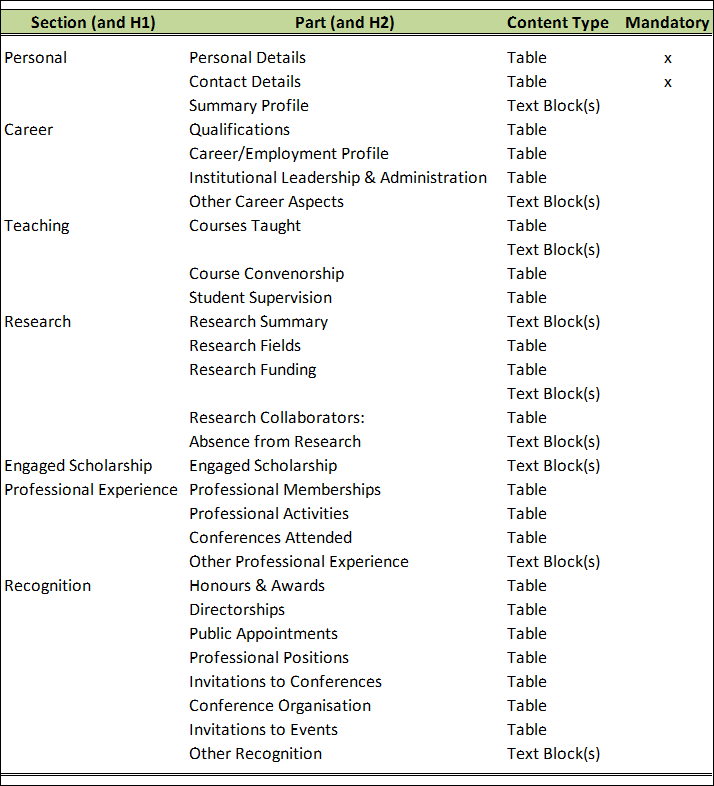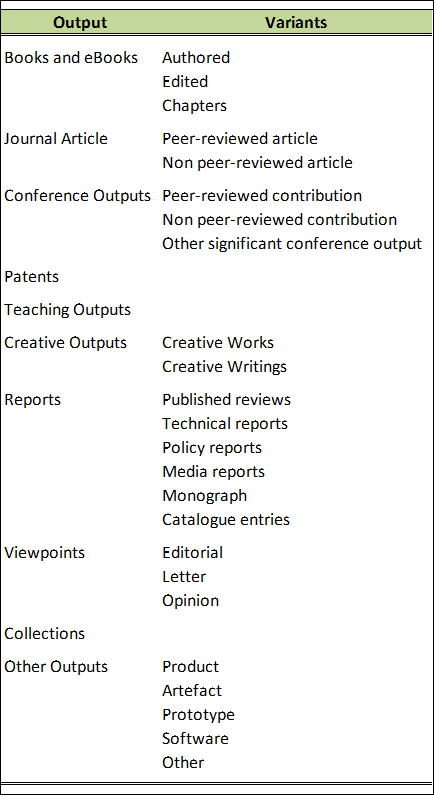
Contents: Hide
The overall purpose of the Researcher Profiles (RP) and Scholarly Outputs (SO) modules in the Research Portal is to provide a mechanism for the entry and editing of the information that comprises a Researcher’s CV/Profile and for this information to be made available as a printable document in Microsoft Word format and/or as a web page. The term “CV” is used to refer to a printable file and the term “Profile” to refer to a web page. Scholarly Outputs entered via the SO module can be incorporated into a Researcher’s CV/Profile and can also be selected for display on a departmental or research group web page.
Mechanisms are provided to allow selection of a subset of the information captured in the RP and SO modules for output to a CV/Profile. This selection capability, combined with pre-defined output templates, supports the easy creation of different versions of a CV/Profile, e.g. full academic CV, short CV, NIH “biosketch”, Profile for display in department A, Profile for display in research unit B, etc. Selection capability for scholarly outputs permits generation of bibliographic citation listings for all outputs, listings of specific output types in the last “n” years, “best-10” outputs, etc.
All UCT academic staff and post-doctoral fellows can create/edit their own CV/Profile and associated scholarly outputs. PASS staff and postgraduate students should apply to the Research Office which can then enable them to create/edit their own CV/Profile and associated scholarly outputs. Any staff member or student who has the ability to create/edit their own CV/Profile and associated scholarly outputs can designate one or more persons to act as their proxy for entering and editing information into the RP/SO system.
See also: Overview: Researcher Profile module and Overview: Scholarly Outputs
Examination of a typical academic CV shows that it is composed of some material presented as tables and other material as blocks of text. Several of our academic colleagues from different faculties were kind enough to provide copies of their current CVs and these were analysed to determine a structure and content that could be used for the CV/Profiles defined using the RP module. The structure of a CV/Profile as captured in the RP module is shown in Table 1 below. It consists of “sections” and a set of “parts” within each section where each part contains material in the form of a table and/or one or more text blocks. When a CV is produced by the RP module as a printable MS Word file then the section names become the top-level (H1) headings and the part names become second-level (H2) headings. When an online profile is produced by the RP module then the sections become separate “tabs” within a single web page and the part names become headings within each tab.
Where the content type as shown in Table 1 is given as “Table” this indicates the data are collected using a user interface with separate specified fields and that the content from a set of such fields can be assembled to constitute a row in a table. Where the content type is given as “Text Block(s)” the data consist of a title (which becomes an H3 heading on output) and a field that can contain a block of text (with one or more paragraphs), portions of which can be formatted with rich text controls (e.g. as bullet lists, numbered lists, bold or italic characters, superscripts or subscripts, etc.).
As indicated in Table 1, only two parts of a CV/Profile are mandatory – these being Personal Information and Contact Details. In addition to those, you can use as many or as few sections and parts as are needed to contain the information that you want in your CV or profile. A good starting point is to take your current CV and to decide how best you could allocate its various components to the sections and parts shown in Table 1.

Table 1: Content and structure of CV/Profile information
The SO module provides the user interface for the capture and editing of information about scholarly outputs. The term “scholarly outputs” is used deliberately to indicate that these include output types which would not be considered as publications. The types of scholarly outputs are listed in Table 2 below.
Capturing scholarly outputs is inherently a tedious process as many different fields need to be captured for each output object. For that reason, we have provided a mechanism for uploading the information from a RIS-formatted file. Files in this format can be downloaded from many online sources such as Scopus and Mendeley. Most desktop or web-based bibliographic or reference management programs (e.g. EndNote, Reference Manager, Mendeley, RefWorks) can also export selected references in RIS-formatted files. Where an online source does not provide a facility for exporting selected references directly to a RIS-formatted file (e.g. PubMed, Web of Science), it is often possible to generate an export file which can be imported into a reference management program (e.g. EndNote, RefWorks) and that program can then be used to generate and export a RIS-formatted file.
For all scholarly outputs there is a further step beyond entering or importing the information that describes the output object and this is to identify all UCT-based authors and to link these to their staff or student numbers. This is necessary so that any output object will be correctly associated with a UCT author or authors and it means that any output with more than one UCT author need only be entered or imported once.

Table 2: Types of scholarly outputs and some different variants thereof

The number of variants for certain output types, e.g. teaching outputs, creative works, and collections will increase with time.
Our intention is to synchronise the information entered and edited in the RP and SO modules with the NRF Online system. We hope to introduce this synchronisation facility by the end of 2015, but as this will require significant assistance from NRF it is not possible to make this a firm date. The main consequence of our plans to synchronise with NRF Online is that there are many fields in the RP and SO module data that are there because they are mandatory in the NRF system. These fields are marked as “NRF required” in the data capture screens. If these fields are not also “UCT required” then they may be left unfilled until such time as NRF synchronisation is available and you wish to use this synchronisation functionality.